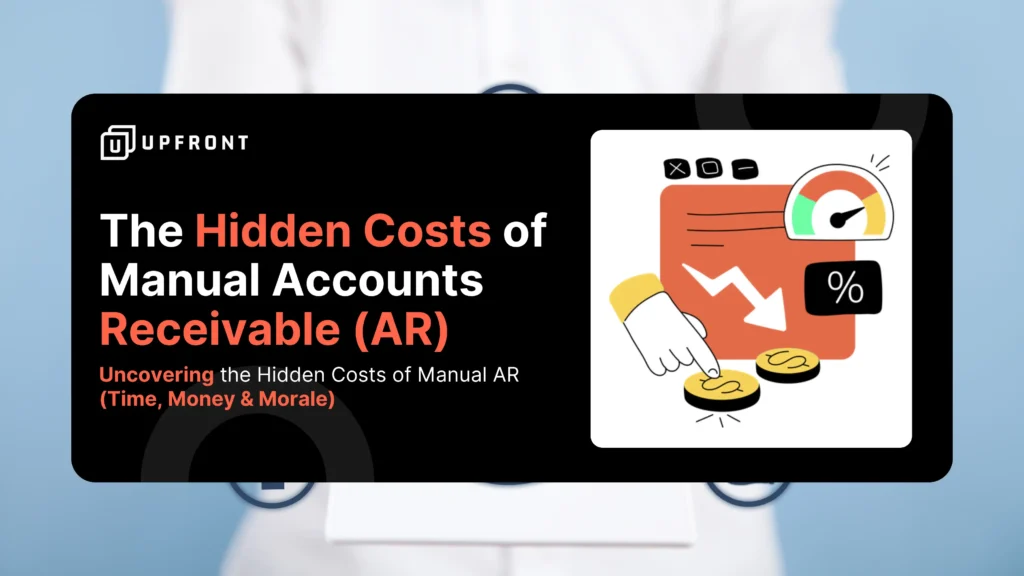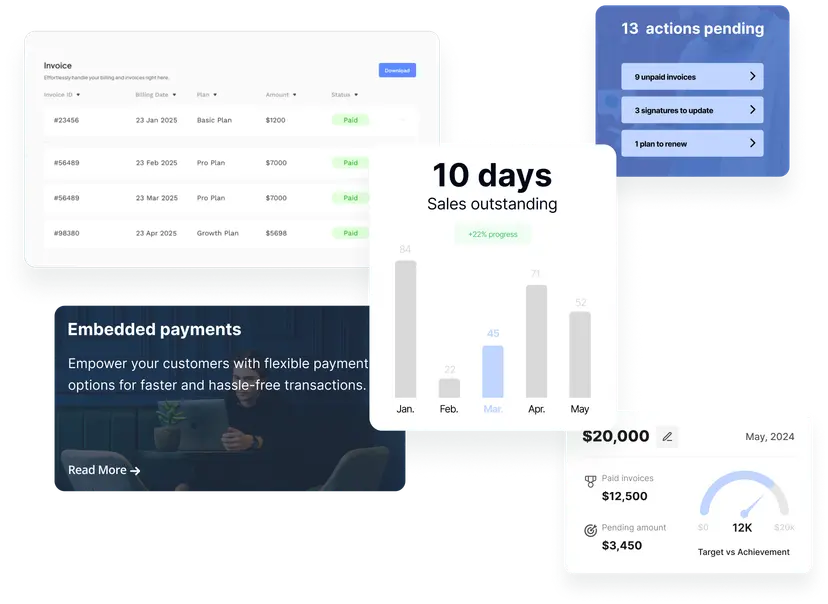The Hidden Costs of Manual Accounts Receivable Management: Why Automation is a Game Changer
For many businesses, managing accounts receivable (AR) manually might seem like a simple and manageable solution. However, the true costs of manual AR processes often go unnoticed, and these inefficiencies can lead to wasted time, money, and missed opportunities for growth.
From labor-intensive tasks to delayed payments, the hidden costs can quickly add up and hold your business back. In this article, we’ll uncover the true costs of manual AR, the inefficiencies in manual AR processes, and how AR process automation through platforms like UPFRONT can help you save time, reduce errors, and improve cash flow.
What Are the Hidden Costs of Managing Accounts Receivable Manually?
While manual accounts receivable processes may appear straightforward, they often hide several costly inefficiencies. These hidden costs can drain resources and negatively affect your business’s financial health. Let’s explore the various hidden costs associated with manual AR:
- Labor Costs: Manual AR requires a significant amount of time from employees who could be focused on higher-value activities. Businesses often spend a substantial portion of their finance team’s time on manual invoicing, payment tracking, and follow-ups.
- Delayed Cash Flow: Slow and inconsistent invoicing processes can lead to delayed payments, which in turn negatively affect your working capital and cash flow.
- Error Rates: Manual data entry is prone to mistakes, from incorrect payment amounts to missed customer details. These errors can lead to additional time spent fixing issues and delays in payments.
- Customer Churn: Inefficient AR processes can frustrate customers, resulting in poor relationships and even customer churn due to invoicing mistakes or delays in collections.
How Much Does Manual Invoicing Cost a Business?
The costs of manual invoicing can add up quickly. Studies estimate that it costs between $16–$22 per invoice when done manually, compared to just $3–$4 when the process is automated. These costs arise from labor-intensive tasks such as creating invoices, sending reminders, and following up on overdue payments. Additionally, the time spent tracking payments and reconciling accounts further adds to the financial burden. By automating your invoicing process with a platform like UPFRONT, you can significantly reduce these costs and free up your team to focus on more strategic tasks.
The Disadvantages of Manual Accounts Receivable
Manual AR processes come with several significant drawbacks that hinder business efficiency:
- Time-Consuming: Manual processes, from data entry to payment reconciliation, are slow and often prone to errors, consuming valuable time.
- Increased Error Rates: Human errors are common in manual AR workflows, whether in payment amounts, customer details, or tax calculations, leading to delays and costly corrections.
- Compliance Risks: Manual processes are prone to non-compliance, especially in environments with complex tax laws, such as VAT. Missing tax filings or incorrect calculations can result in costly penalties.
- High DSO (Days Sales Outstanding): Manual AR processes often result in slower collections, which directly impacts DSO and liquidity, leading to cash flow challenges.
Why Should Businesses Automate Their AR Process?
The benefits of automating accounts receivable are clear. Here’s how AR automation through UPFRONT can transform your business:
- Faster Payments: Automated invoicing ensures invoices are generated and sent promptly, reducing delays and accelerating payment collection.
- Fewer Errors: By automating data entry and payment tracking, AR automation reduces the risk of human errors, leading to more accurate invoicing and quicker resolutions of issues.
- Real-Time Tracking: With AR automation, you gain access to real-time insights into your payments, allowing you to make informed decisions about cash flow and collections.
- Increased Efficiency: Automation eliminates repetitive tasks, freeing up your team to focus on more impactful activities like customer service, strategic planning, and financial analysis.
How Does Manual AR Affect Cash Flow?
Manual AR processes can have a significant negative impact on cash flow. Delayed invoicing and inconsistent follow-up on overdue payments mean that cash is tied up in accounts receivable for extended periods. Without real-time tracking and automated reminders, businesses often miss opportunities for faster payments, leading to delayed collections and higher DSO. The result is restricted working capital, which can prevent businesses from reinvesting in growth opportunities or paying their own vendors on time.
Is Manual Accounts Receivable Slowing Down Business Growth?
For businesses focused on growth, manual AR processes are a major bottleneck. The more time your team spends on manual invoicing, payment reconciliation, and chasing late payments, the less time they have to focus on scaling the business. As your business grows, manual processes become increasingly difficult to manage, leading to higher costs, delayed payments, and missed opportunities for reinvestment.
Real Cost Comparison: Manual vs. Automated AR
When comparing the costs of manual invoicing to the benefits of AR automation, the difference is clear. Here are some of the key areas where automation provides a significant return on investment (ROI):
- Time Savings: Automating your AR processes can save your team 20-50% of their time, allowing them to focus on higher-value tasks.
- Faster Payments: With UPFRONT, businesses can reduce DSO by ensuring faster invoicing and automatic payment reminders, resulting in quicker payments and improved cash flow.
- Reduced Errors: AR automation minimizes the risk of costly mistakes, ensuring more accurate invoicing and improved customer satisfaction.
- Lower Operational Costs: Automation reduces the need for manual labor and external resources, which helps lower overhead costs.
Hidden Costs of Manual AR – A Quick Overview
| Cost Type | Examples | Impact |
|---|---|---|
| Time Costs | Manual invoicing, data entry, payment follow-ups | Payroll, staff capacity |
| Direct Financial Costs | Errors, delayed payments, bad debt, paper costs | Profits, working capital, cash flow |
| Morale Costs | Frustration, low satisfaction, burnout | Team productivity, retention costs |
| Opportunity Costs | Missed growth opportunities, slow decisions | Strategy, scaling, competitiveness |
Manual AR draining your team’s time and energy?
UPFRONT automates your receivables workflow — reducing admin work, speeding up collections, and freeing your team to focus on what matters.
When Is It Time to Automate?
If your business is still using manual AR processes, it may be time to consider automation. When you start to experience inefficiencies, errors, and delays, it’s clear that automation is necessary. Tools like UPFRONT can automate your receivables workflow, improving efficiency, reducing errors, and allowing your team to focus on business growth rather than administrative tasks.
Ready to transform your accounts receivable process?
Book a free demo of UPFRONT today and see how automation can streamline your AR process, improve cash flow, and drive growth.
FAQs
1. What are the hidden costs of doing AR manually?
The hidden costs of manual AR include labor costs, delayed payments, errors, and missed opportunities for growth. These costs drain cash flow and hinder your business’s ability to scale effectively.
2. How much time can automation save my finance team?
AR automation can save businesses between 20-50% of the time their finance team would otherwise spend on manual tasks like invoicing, sending reminders, and reconciling payments.
3. What are the most common mistakes with manual accounts receivable?
Common mistakes in manual AR include typos in customer information, incorrect payment amounts, missed invoices, and VAT miscalculations, all of which can delay payments and lead to costly errors.
4. How does AR automation improve cash flow?
AR automation improves cash flow by ensuring faster invoicing and automatic payment reminders, which reduce Days Sales Outstanding (DSO) and help businesses collect payments more quickly.
5. Is manual accounts receivable slowing down my business growth?
Yes, manual AR processes are a major bottleneck for growth. As businesses scale, manual processes become more inefficient, leading to slower collections, higher costs, and missed opportunities for reinvestment.
6. How does AR automation reduce costs compared to manual processes?
AR automation reduces costs by saving time, eliminating errors, speeding up collections, and reducing overhead costs associated with manual invoicing, follow-ups, and reconciliations.
Conclusion: Overcoming Manual AR Challenges with Automation
The hidden costs of manual AR are far-reaching, from wasted time to missed growth opportunities. By automating your accounts receivable process with UPFRONT, you can reduce time spent on repetitive tasks, improve cash flow, and focus on growing your business. Don’t let manual AR hold your business back—automate today to unlock your full potential.
→ Resource liberation: Time-Saving Tips SME Efficiency→ Scalable solutions: AR Automation for Small Business→ Growth catalyst: Financial Software SME Growth→ Payment flexibility: Accept Online Payments→ Hidden savings: Costs of Manual AR





